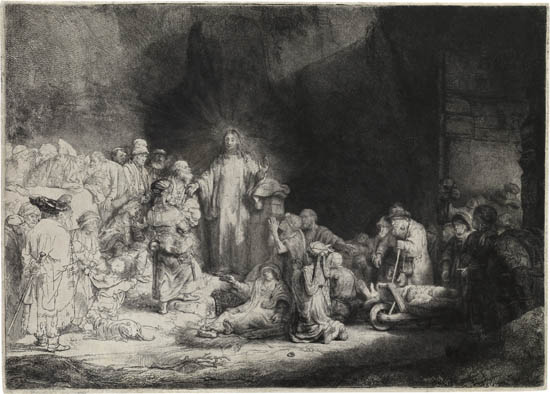Sale 2292 - Lot 159
Unsold
Estimate: $ 150,000 - $ 200,000
REMBRANDT VAN RIJN
Christ Healing the Sick (The Hundred Guilder Print).
Etching, engraving and drypoint, circa 1643-49. 279x388 mm; 11 1/8x15 1/4 inches, narrow margins. Biörklund's second state (of 2), before the Watelet and Baillie rework; Usticke's third state (of 5); White and Boon's second state (of 2). Strasburg Lily watermark (Hinterding I-c-a). A brilliant, richly-inked, dark, early impression, with burr on the back of the standing woman and the seated man to her left with his hand over his face, on the robes of the kneeling figure lower right and the woman on the stretcher and elsewhere in the background, with lovely contrasts in the shadows on the right side of the composition and crisp, partially inky plate edges.
According to Hinterding, "The Hundred Guilder Print has since its creation been admired as Rembrandt's most ambitious, complex and highly worked composition as a printmaker." He adds that the subtitle for the print might have originated early, as it was already noted , "In a letter from Jan Meyssens of Antwerp to Charles vanden Bosch, Bishop of Bruges, dated 9 February 1654, 'Also here is the rarest [i.e. finest] print by Rembrandt, in which Christ is healing the sick, and I know that in Holland [it] has been sold various times for 100 guilders and more," (Hinterding, Rembrandt the Printmaker, London, 2000, pp. 253-54). The amount of a hundred guilders was equivalent to around 4 months wages for an unskilled laborer in Rembrandt's Amsterdam at the time. Peter Minuit, the Director of the Dutch colony of New Netherland from 1626 until 1633, reportedly purchased the island of Manhattan from Native Americans on May 24, 1626 for goods to the value of 60 Dutch guilders.
The scriptural basis for the etching is from chapter 19 of the gospel of St. Matthew, particularly the lines, "Then there were brought unto him little children, that he should put his hands on them, and pray. And the disciples rebuked them; but Jesus said: Suffer little children, and forbid them not, to come unto me; for of such is the kingdom of heaven." Two mothers with their children are seen approaching Christ from the left, the one closest with the child in her arms is pushed back by the bearded St. Peter standing directly to Christ's right. From the same chapter orignated Christ's often quoted warning, "It is easier for a camel to go through the eye of a needle than for a rich man to enter the kingdom of God." Rembrandt represents this admonition in the figure of the wealthy, young, well-dressed man seated in contemplation between the women with their children at the left and with the camel at the far right of the etching. Finally, the Pharisees, who attempted to argue with Christ on the legality of divorce in chapter 19 of the gospel of St. Matthew, are seen in highlight in the upper left of the composition. Bartsch 74; Biörklund 49-1; Hollstein (White and Boon) 74.
Christ Healing the Sick (The Hundred Guilder Print).
Etching, engraving and drypoint, circa 1643-49. 279x388 mm; 11 1/8x15 1/4 inches, narrow margins. Biörklund's second state (of 2), before the Watelet and Baillie rework; Usticke's third state (of 5); White and Boon's second state (of 2). Strasburg Lily watermark (Hinterding I-c-a). A brilliant, richly-inked, dark, early impression, with burr on the back of the standing woman and the seated man to her left with his hand over his face, on the robes of the kneeling figure lower right and the woman on the stretcher and elsewhere in the background, with lovely contrasts in the shadows on the right side of the composition and crisp, partially inky plate edges.
According to Hinterding, "The Hundred Guilder Print has since its creation been admired as Rembrandt's most ambitious, complex and highly worked composition as a printmaker." He adds that the subtitle for the print might have originated early, as it was already noted , "In a letter from Jan Meyssens of Antwerp to Charles vanden Bosch, Bishop of Bruges, dated 9 February 1654, 'Also here is the rarest [i.e. finest] print by Rembrandt, in which Christ is healing the sick, and I know that in Holland [it] has been sold various times for 100 guilders and more," (Hinterding, Rembrandt the Printmaker, London, 2000, pp. 253-54). The amount of a hundred guilders was equivalent to around 4 months wages for an unskilled laborer in Rembrandt's Amsterdam at the time. Peter Minuit, the Director of the Dutch colony of New Netherland from 1626 until 1633, reportedly purchased the island of Manhattan from Native Americans on May 24, 1626 for goods to the value of 60 Dutch guilders.
The scriptural basis for the etching is from chapter 19 of the gospel of St. Matthew, particularly the lines, "Then there were brought unto him little children, that he should put his hands on them, and pray. And the disciples rebuked them; but Jesus said: Suffer little children, and forbid them not, to come unto me; for of such is the kingdom of heaven." Two mothers with their children are seen approaching Christ from the left, the one closest with the child in her arms is pushed back by the bearded St. Peter standing directly to Christ's right. From the same chapter orignated Christ's often quoted warning, "It is easier for a camel to go through the eye of a needle than for a rich man to enter the kingdom of God." Rembrandt represents this admonition in the figure of the wealthy, young, well-dressed man seated in contemplation between the women with their children at the left and with the camel at the far right of the etching. Finally, the Pharisees, who attempted to argue with Christ on the legality of divorce in chapter 19 of the gospel of St. Matthew, are seen in highlight in the upper left of the composition. Bartsch 74; Biörklund 49-1; Hollstein (White and Boon) 74.

Exhibition Hours
Exhibition Hours
Aliquam vulputate ornare congue. Vestibulum maximus, libero in placerat faucibus, risus nisl molestie massa, ut maximus metus lectus vel lorem.


